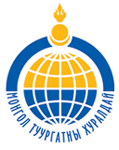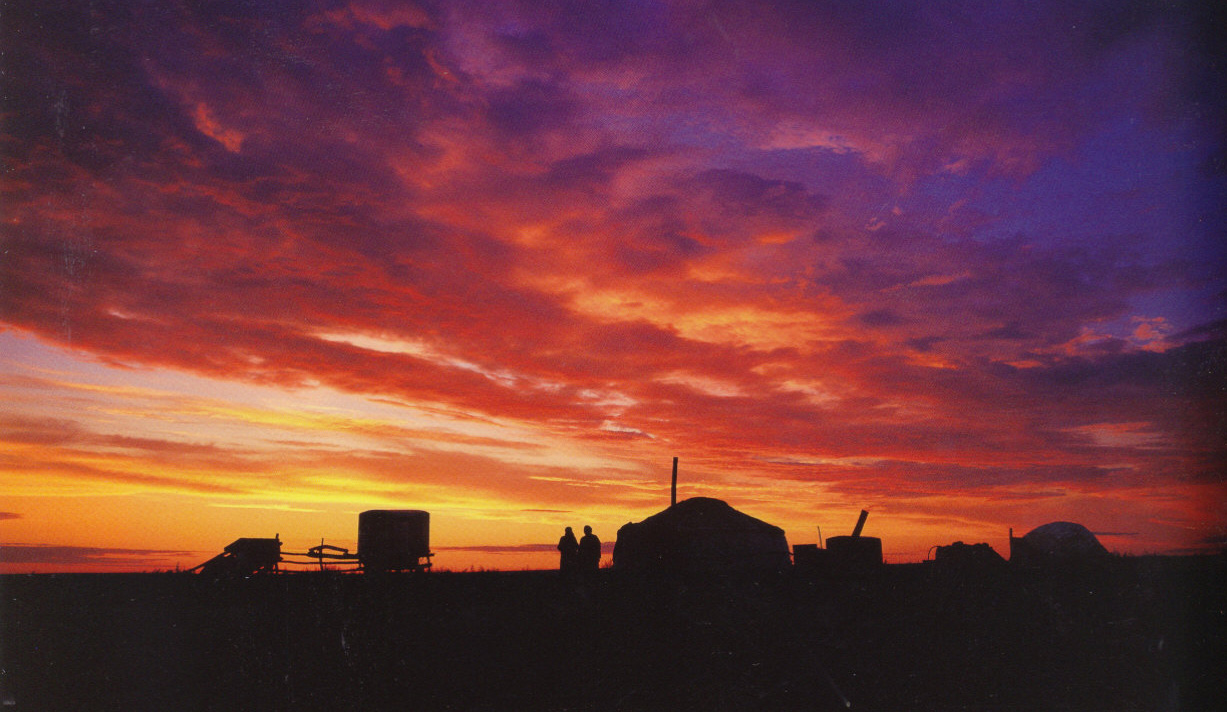
Uryankhai Tuva n Niislel Tos-Bulak t; Khuresh(Buhiin Barildaan)
In Tos-Bulak, The capital of Uriankhai-Tuva; Khuresh(Wrestling)
In Tos-Bulak, The capital of Uriankhai-Tuva; Khuresh(Wrestling)
Asoshyoriu Dagvadorj, Japan ii mergejliin sumo n 68 dahi Ih Avarga
The 68th Yokozuna (Great Champion) of Japanese Professional Sumo
 Mongolian Wrestling
Mongolian WrestlingEvery Mongolian loves Wrestling. Mongolian Wrestling which is one the “Men’s Three Hard Games-Nagadum” was first held around 2500 B.C in the time of Hunnu Empire. Thus Mongolian Nagadum (In the Writing system of Traditional Hudan Script) and/or Mongolian wrestling is the second oldest Olympic Games only after the Greek Games. (Different spellings for Nagadum are Naadam [Central Khalkha pronouncing]; Naadym [Uriankhai-Tuvan pronouncing])
Today the ancient Mongolian Wrestling form is most practiced among the wrestlers of The Autonomous Republic of Inner Mongolia “TARIM” in China; but in the other Mongolian countries such as The State of Mongolia the style and rule had changed significantly in last two hundred years. As written in The Secret History of Mongolia, Buri Bukh a strong wrestler and body guard of his clan chief Sacha Bekhi, held Belgutei (Chingis Khan’s younger brother)’s arm in his hand and tightened his legs under his thigh that Belgutei could not make a single movement. Likewise “TARIM” wrestlers only take actions to his opponents through arm to arm and leg to leg, whereas in other regions, for example Buryat, Uriankhai-Tuva in Russian Federation and The State of Mongolian, both legs and arms are allowed to handle his opponent’s. In earlier Mongolian states Bukh people served as bodyguards and must trusted people of his Khagan (Different spellings for Khagan are Khan and Khaan) zaisan and chief, because in Mongolian system of morality and education Bukh people taught to be strong but mild, genuine and humanitarian in mind. Nevertheless as reading and listening to the folk songs, literacy; in the most cases those behaviors come naturally to Bukh.
In 2006, 2048 “TARIM” Bukhs assembled in Shiliin Gol province to make a new record in The Guinness Book. 2;4;8;16;32;64… sequence that indicating the permitted bukh number at one Nagadum time is invariable and never changed its form even today. One example is on every annual ceremony of central Khalkha’s Socialist Revolution, 512 or 1024 bukh is presented in the Central Stadium of The State of Mongolia.
Mongolian National Wrestling played a key role in developing and flourishing of the modern or different Wrestling sports. Southern Mongolian style of wrestling is similar to the technique of Classical Greek and Roman wrestling. Northern Mongolian style is almost identical to SAMBO and JUDO; and the third most practiced wrestling of Western Mongolians’, especially Oirat Mongolians’ “Bukh Noololdoon-Bull fighting” has a strong connection to the basis of Free Wrestling. In a way Mongolian wrestling culture gives wide technique capacity, mind freedom and gravitas to the people who study it. A successful Mongolian wrestler Batbayar who was Japanese Sumo wrestler for almost a decade received the title “hypermarket of wrestling technique” in Japan. Currently many Mongolian bukh are wrestling in Japan as sumo. Must gifted among them are Dagvadorj given the title name Asoshoryu (朝青龍) and Davaajargal given the title name Hakuho(白鵬 翔), who are the 68th and 69th Yokozunas or Great champions of Japanese professional sumo wrestling. These two grand champions leaded the winner chart of Sumo for last three years. This era will be recorded in the history of Sumo as Mongolian Leadership, proudly.
Although Mongolian Wrestling has a long chain to the forgotten past, the written materials from Manchu’s Qing Dynasty was saved, only. Therefore it is possible to find much about wrestlers from 1700’s but previous time wrestlers’ extraordinary life can be found in the oral literacy and folk songs of people of Mongolia. An unforgettable one is the history of Lady Bukh who went to participate in the Nagadum in the name of his harsh injured brother. After winning all the bukhs of that particular Nagadum an old wise teacher found that the champion was a woman by observing her steps while she did the welcoming ritual “Devee Shavaa.” From that Nagadum Mongol bukh’s top clothing “Zodog” no more had opening in the back but in the front.
The dressing of Mongol bukh consists of “Zodog” a top wear and “Shuudag” an under clothing. Even though the dress style had changed in last 150 years, there exists two main way of dressing. First one is made of cotton or half silk fabric and has shape of short, tight blue or reddish pink color, which looks like a swim wear. The second one’s Zodog is made by leather and has metal, silver or golden ribs on it; the Shuudag is long and wide with “Tvmen Nasan-Long Life Ornament”
From 1800’s Tuv Khalkha Wrestling created an Award System, which gives the title “Arslan-Leo” for one time champion and “Avarga-Chief” for two time winner. While in the Southern parts, capital-home to the last kings-khans of Mongolia, the award system is different. Winners do not get any title but rather receive colored ribbons on each case of winning.
The new, present day award titles of The State of Mongolia (Central Khalkha) :
Nachin “Young Hawk”-Kharcaga “Mature Hawk”-Zaan “Elephant”-Garid “a myth bird”-Arslan “Leo”-Avarga “Chief”
Nowadays Mongolian bukh only wrestle in their private regions probably due to the hazardous situation of the 19th and 20th century. Just few young wrestlers from The State of Mongolia (Central Khalkha) occasionally go to TARIM that allows young bukh to get more experience. This disconnection increases the possibility of loosing the traditional culture of Mongolian Wrestling and if it continues the opportunity of forgetting bukh is present in the distant regions of Mongolian nation.
Mongol Bukhinn urlagiin talaar sonirholtoi yarilclaga ugsun S.Batbold tanid talarhlaa ilerhiiley.
Hvndetgesen "Mongol Tuurgatnii Huraldai"
Thank you for your interview Mr.Batbold.S
Sincereley "Mongol Tuurgatnii Huraldai"
Survaljilsan Kherlen Borjigon, by Kherlen Borjigon
Oyunii Umchiig Huuliar Hamgaalna. All Rights Reserved


No comments:
Post a Comment